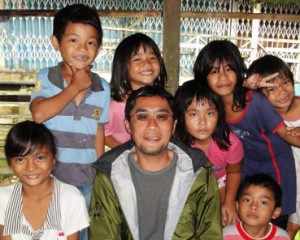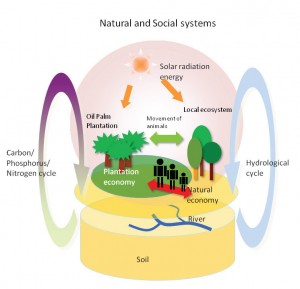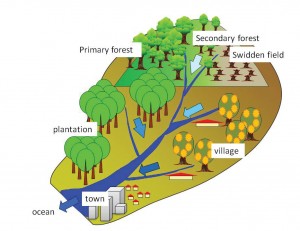 The equatorial areas of Southeast Asia are well known for their high concentration of biomass, which accumulates with the combination of high solar radiation energy and heavy rainfall. The region has also been a fertile ground for the appropriation and commodification of natural resources. In the past few decades this tropical zone has undergone a fast-paced metamorphosis that has raised concerns as to the present and future of its biomass and societies dependent on it.
The equatorial areas of Southeast Asia are well known for their high concentration of biomass, which accumulates with the combination of high solar radiation energy and heavy rainfall. The region has also been a fertile ground for the appropriation and commodification of natural resources. In the past few decades this tropical zone has undergone a fast-paced metamorphosis that has raised concerns as to the present and future of its biomass and societies dependent on it.
This fundamental transformation of biomass is a common feature to many societies in insular Southeast Asia. Thus, the landscape of rainforest-cum-plantation fields offers us a proper locale to examine a biomass shift from jungle produce, cultivated rubber and timber, to oil palm and Acacia mangium, signalling a new form of time-space compression, where deforestation, plantations, and reforestation work simultaneously within the context of global energy crisis and climate change.
Our five-year project funded by Japan Society for Promotion of Science (JSPS), is a multi-sited, multi-disciplinary study, and a strategic combination of field sciences. To understand the transformation of high biomass society in maritime Southeast Asia, our research focuses on the articulation points between social systems and natural systems.
Our team members, both social and natural scientists, engage in the study of connections. From community, region, nation-state, to empire – or from patches of lands to riverine landscapes, the scaling and rescaling of the units of analysis in time and space allow us to comprehend how constituent parts of a system are related, and distant places linked. What is attempted at micro-, meso- and macro-levels is the search for a common ground that makes possible the investigation of the convergences that exist between geosphere, biosphere and human habitats in the newly emergent landscapes of planted forests.
While the science of nature and technology has dealt with material flows such as water, gases, and minerals through physical and biological processes, social science has specifically focused on the nature of both natural and plantation economies, micro-socio-economic relations connecting local communities, commodity chains and webs linking hills and plains, and the global reconfiguration of micro-macro relatedness. The strength of this project lies in the strategic combination of field sciences, designed to shine the analytical spotlight on the areas of convergence and the linkages that create them.
We aim to comprehend the nature of such connections, circulations and the structural determinants, examining the relations between nature undergoing intense transformation and human communities, taking planted forests as a case in point. Through collaboration between specialists from the fields of anthropology, geography, sociolinguistics, global history, political economy, environmental economics, plant, animal and forest ecology, hydrology, soil science, and life cycle assessment, we aim to examine the multi-dimensional driving forces of change in nature/non-nature interactions in a heterogeneous landscape consisting of oil palm and Acacia mangium plantations, primary and secondary forests, and swidden fields.
Ecological research has been designed to understand eco-systems of natural and planted forests. At a local level, multiple research plots are selected by ecologists, with regard to the spatial structure of biodiversity, nutrient cycle such as nitrogen and particulate organic matter in the forests and in the river. Hydrological research looks into water cycles in the ocean, the atmosphere, the forests, and the rivers, in several tens of square km at a mesoscale. Socio-cultural research attempts to examine the regime shift of local communities, from traditional natural economies (swidden cultivation, and hunting and gathering of non-timber forest produce) with wage labor at timber camps to newly emergent combinations of oil palm smallholding with income generation through off-farm/urban wage labor. A series of household interviews will also be conducted by anthropologists and geographers who look into the economic portfolio of rural communities, and commodity webs connecting various social groups in hills and plains.
The human-nature interactions that are the focus of the project highlight a number of larger questions regarding resource and environmental, not to mention development governance. Plantations in insular Southeast Asia have been endorsed by various systems of certification and financially backed by the international community in search of a sustainable development path for human societies. Planted forests of oil palm and Acacia mangium as a potential energy source are thought to be good for carbon emissions, and financial sector seeks to create instruments for the securitization of tropical biomass under the newly proposed REDD and REDD Plus (Reducing Emissions from Deforestation and Degradation) initiative. The result is a dynamic process of negotiation within an increasingly complex threshold between nature and non-nature.
Those of us engaged in this new project examine whether or not societies located in the tropics can find an alternative path toward their own sustainability. The feasibility of planted forests as a sound ecological and socio-economic base for local communities can only be worked out through collaborative research that cuts cross-disciplinary field studies and encompasses a holistic mix of both the social and natural sciences. The transformation of Southeast Asian biomass society reflects many opportunities and challenges faced in other equatorial zones in the world. We hope that our research will show how Insular Southeast Asia can serve as an important locale to test the resilience of local communities of people, fauna, and flora in the search for strategies to adapt to the emergent forces driving large-scale landscape transformation.
[External Link] JSPS:Japan Soceity for the Promotion of Science


